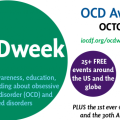Obsessive-Compulsive Disorder (OCD) – Overview
What is OCD?

Obsessive-compulsive disorder (OCD) is an anxiety disorder that affects about 2.5% of the population.
Obsessive-compulsive disorder (OCD) is a debilitating mental illness that affects nearly 2.5% of the population (American Psychiatric Association, 2000). The primary features of the disorder include obsessions, which are recurrent and persistent thoughts, impulses, or images that cause severe anxiety and distress; and compulsions, repetitive behaviors or mental acts performed in response to an obsession. Compulsions frequently are performed to reduce distress or prevent a dreaded event or situation from occurring. Because individuals with OCD often spend many hours each day experiencing obsessive-compulsive symptoms, the disorder severely impairs functioning across a variety of domains.
According to Rasmussen (2005), individuals with OCD tend to adhere to highly rigid and disciplined notions about how to do things properly, “sacrificing opportunities for positive, pleasurable activities to maintain a position of disciplined appropriateness” . Consistent with this view, cognitive rigidity has been proposed as a hallmark feature of the disorder. Even in the absence of clinical OCD, individuals who exhibit a high degree of obsessive-compulsive characteristics also have been shown to be cognitively and behaviorally rigid (e.g., Cabedo, Belloch, Morillo, Jiménez, & Carrió, 2004; Mythili & Devi, 1982; Zohar, LaBuda, & Moschel-Ravid, 1995). In an early description of OCD, Lion (1942) described a group of individuals diagnosed with “anancastic depression[1]” as being “indecisive, scrupulous, markedly superstitious…paralyzingly meticulous, and inclined to have morbid doubts” . Current conceptualizations of OCD overlap with these early descriptions of the disorder and emphasize an association between OCD and inflated perfectionism, intolerance for uncertainty, and rigidity (e.g., Cabedo et al., 2004; Schultz & Searleman, 2002; Shapiro, 2001).
How do these features present clinically? Consider the case of a man with “Hit and Run” OCD who has recurrent obsessive thoughts that he has struck a pedestrian with his car while driving. Although he has no actual recollection of hitting anyone, he nevertheless experiences persistent doubt related to whether he might have injured someone inadvertently. These thoughts increase in intensity until the man retraces his driving route and checks the road for injured pedestrians. Although the act of retracing and checking his route partially effects a reduction in anxiety, further doubt is aroused by the potential for having injured someone during the subsequent check and/or having overlooked evidence of an injured party during the check. This scenario might replay itself numerous times over the course of a single commute, each time culminating in the man retracing his route to check for signs of an accident. Although the man reports that he would like to be able to complete a commute without retracing his route, he feels unable to do so due to the OCD doubt and uncertainty that he experiences while driving. These motor vehicle accident (MVA) OCD symptoms can be debilitating.
Alternatively, consider the case of a woman with OCD who experiences obsessive thoughts related to contamination and disease after visiting the restroom. The anxiety aroused by these thoughts is reduced by performing extensive hand washing rituals. Washing persists for up to thirty minutes per occasion, by which time the anxiety aroused by the obsessive thoughts has been reduced sufficiently for the woman to feel comfortable with discontinuing her washing behaviors. If, at any point in her washing routine, the woman becomes mentally distracted from her task; she restarts her washing ritual from the beginning due to the possibility that her washing has been insufficient for removing all potential sources of contamination. The woman recognizes that her washing rituals are excessive and would like to limit them in order to save time, experience less anxiety, and avoid the self-injury that often accompanies such frequent washings (e.g., chapped, abraded skin); however, she feels unable to manage the anxiety aroused by her obsessive thoughts without washing.
Both of these cases illustrate functionally appropriate behavior being implemented with non-normative limits to the extent that it causes severe impairment. Interestingly, the rituals exhibited by each of these individuals are based around a behavior that itself is considered adaptive in certain contexts. It is adaptive to take measures to prevent or reduce harm to others for the benefit of society or to protect oneself against future prosecution. Similarly, it is adaptive to minimize the likelihood of contracting or spreading disease by performing hand washing behaviors following restroom use. Yet when these behaviors are performed with a frequency or an intensity that interferes with other domains of functioning, the adaptiveness of these actions becomes overshadowed by their maladaptive sequelae.
What, if anything, do we know of the mechanisms underlying this subversion of functional behavior? Read more about the neurobiology of OCD.
Full references for this page can be found here.
Questions? Comments? Sound off below.
Want Updates about New Content?
Follow Me!
Follow @drstevenseay












Hi dottor Seay, i am an italian visitor and i have some question about ocd:
-What are the pratical consequences of cognitive rigidity? Does it related only to the symptoms or affect the general way of thinking of the patients?
-Is conscientiousness only related to the disorder or it is a general oersonality trait in the patients?
-Based on your clinical evidence, are there common personality traits among the ocd patients?
Sorry for the bad english, i hope is understandable at least
Greetings from Italy!
I think it’s important to note that there aren’t any personality traits that are unique to OCD. Everyone has different combinations/amounts of these traits, whether they have OCD or not. There has been a lot of discussion about the types of cognitive distortions that may be associated with OCD. These include cognitive distortions based on perfectionism, intolerance of uncertainty, hyper-responsibility, the need to control thoughts, overestimating the probability of threats, overestimating the magnitude of threats, and emotional reasoning (among others).
Thanks for the answer, i really apprezzate your dedication!